How to Increase Organic Traffic [10 Proven Methods]
Gabriela Jhean
Organic traffic is the lifeline of many successful online businesses. It’s the free, qualified visitors who find your website through search engines like Google.
Building a steady stream of organic traffic requires a strategic approach and consistent effort.
In this post, we’ll dive into 10 proven methods to increase organic traffic and help your website climb the search engine results pages (SERPs).
Table of Contents
What Is Organic Traffic?
Organic traffic comes from visitors who click on your organic listings in search engine results. It does not include any visitors who clicked on paid advertisements.
Organic traffic is earned through search engine optimization (SEO) practices, which involve optimizing your website to rank higher in SERPs.
How to Increase Organic Traffic on Your Website
1. Get to Know Your Audience
Understanding your target audience is the foundation of successful SEO. You can gain valuable insights into their needs, preferences, and pain points by creating detailed buyer personas. This knowledge will inform your content strategy and keyword research efforts.
To truly connect with your audience, consider these steps:
- Conduct in-depth market research. Identify your ideal customer’s demographics, interests, and online behavior.
- Analyze website analytics. Understand your current audience’s behavior and preferences.
- Utilize social media and forums. Connect with your audience where they are — online. Keep a pulse on social media and online forums to stay on top of trends.
By understanding your audience, you can create content that resonates and drives organic traffic to your site.
2. Perform Keyword Research
Keywords are the building blocks of your SEO content strategy. These are the words and phrases people use to search for information online.
Effective keyword research involves identifying keywords (1) relevant to your industry and (2) that you can rank for.
Here’s how to do it:
- Brainstorm relevant keywords. Begin by listing keywords related to your business, products, or services.
- Use keyword research tools. Tools like LowFruits and Semrush can provide valuable insights into keyword search volume, competition, and related terms.
- Analyze competitor keywords. Identify keywords your competitors are ranking for to discover potential opportunities.
- Identify low-competition keywords. Look for keywords with decent search volumes and weak competitors. (LowFruits makes it easy to find low-competition keywords using weak spots. For example, in the screenshot below, each keyword has multiple weak competitors ranking for it. This means it will be easy to rank high in search results for these keywords.)
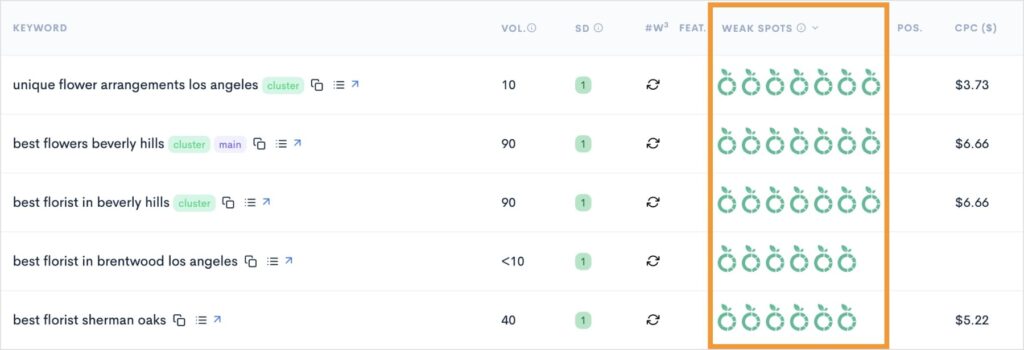
3. Master Search Intent
Understanding the search intent of a keyword is just as important as the keyword itself.
Search intent tells you what motivates a user to perform a search. It’s the why behind a search query.
There are four primary types of search intent:
- Informational: Users are seeking information or answers to a specific query.
- Navigational: Users are looking for a particular website or brand.
- Commercial: Users are researching products or services before making a purchase.
- Transactional: Users are ready to make a purchase or take a specific action.
By deciphering the search intent of a keyword, you can create content that addresses the user’s needs. This creates a more positive user experience that aligns with that stage of the buyer’s journey.
Tip: In LowFruits, you can run a SERP analysis on high-intent keywords with the click of a button. This action fetches keyword ideas related to your original search that have commercial or transactional intent. (These are also called buyer intent keywords because they represent queries with high conversion rates.)
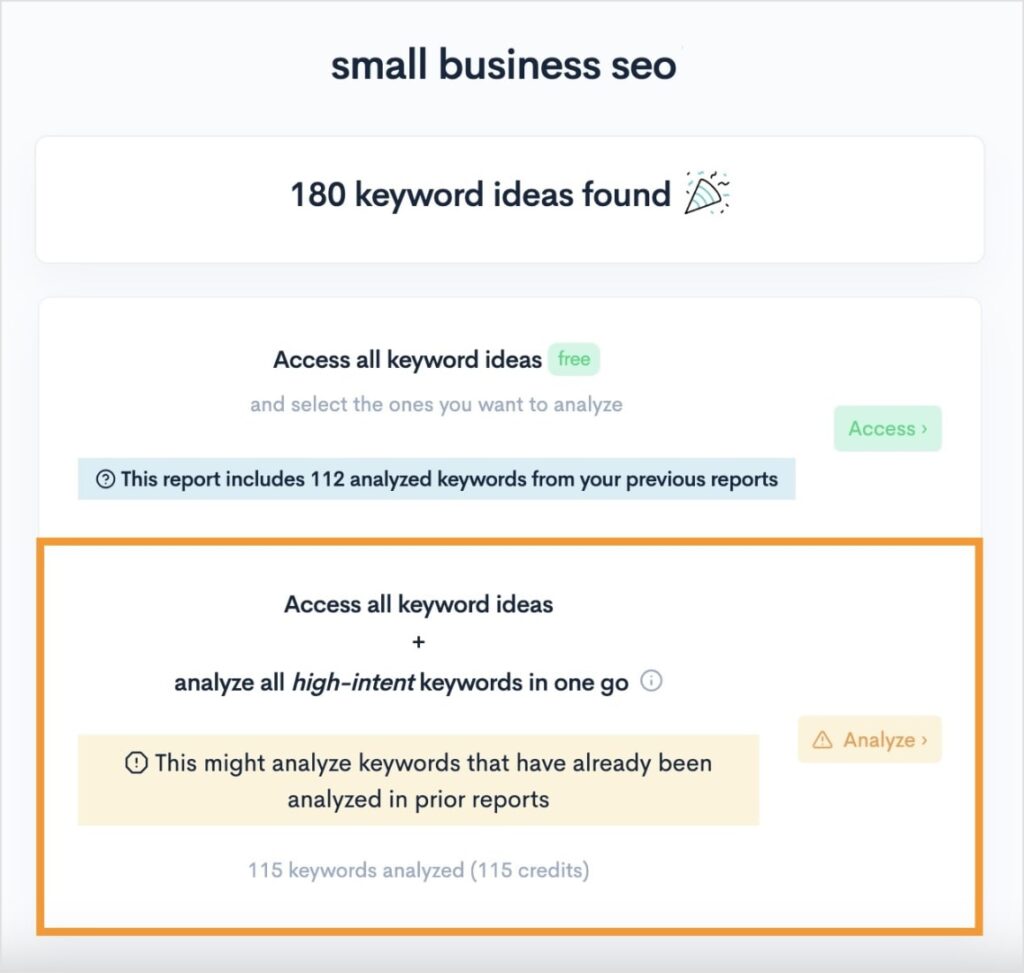
4. Create High-Quality Content
High-quality content is what attracts, engages, and retains your audience.
But what exactly does high-quality content mean anyway?
Luckily, Google offers some insights into what they consider helpful, people-first content.
Here are some of the questions they recommend when assessing your content:
- Does it provide original information, research, or analysis?
- Does the content provide comprehensive coverage of the topic?
- What does it provide users beyond the obvious, i.e., insightful analysis or interesting information?
- Is it well-produced and grammatically correct?
- Is it the type of page or post you’d want to share with a friend or family member?
These questions can guide your content creation efforts and how to evaluate the final piece.
Ultimately, users and search engines want to read valuable and accurate information.
Think of how you can make your content unique and provide genuine value to your audience.
Also, remember: Content is not just about words.
Visuals, such as images, infographics, and videos, can enhance engagement and improve search rankings.
5. Refresh Old Posts and Pages
Don’t let your old content gather dust. Refreshing existing content can be just as effective as creating new content.
In fact, sometimes, it can be an even easier way to get a fast boost in rankings.
That’s because existing content already has a “trail” on the Internet. Search engines have likely already crawled and ranked your page, meaning they already know what it’s about.
By updating old posts and pages, you can increase their relevance in today’s search landscape, improve their rankings, and attract new visitors.
Here’s how to revitalize your older content:
- Identify underperforming content. Investigate your website analytics to find posts with low engagement or traffic.
- Update outdated information. Ensure your content is accurate and up-to-date with the latest trends and data.
- Check if the search intent has changed. Look at the current ranking pages to make sure the search intent has remained the same. If not, adjust your content to align with the updated search intent.
- Expand on existing content. Add new sections, examples, or case studies to provide more value to your readers.
- Optimize for relevant keywords. Incorporate new keywords to improve search visibility.
As for spotting when it’s time to take the above steps, the LowFruits Rank Tracker lets you know when SEO performance starts to slip.
This tool tracks your most important keywords and their position on the SERP.
When you click the Decrease view, you’ll see keywords and pages that are starting to fall in search results. These are pages you’d want to investigate and consider refreshing to revitalize them.
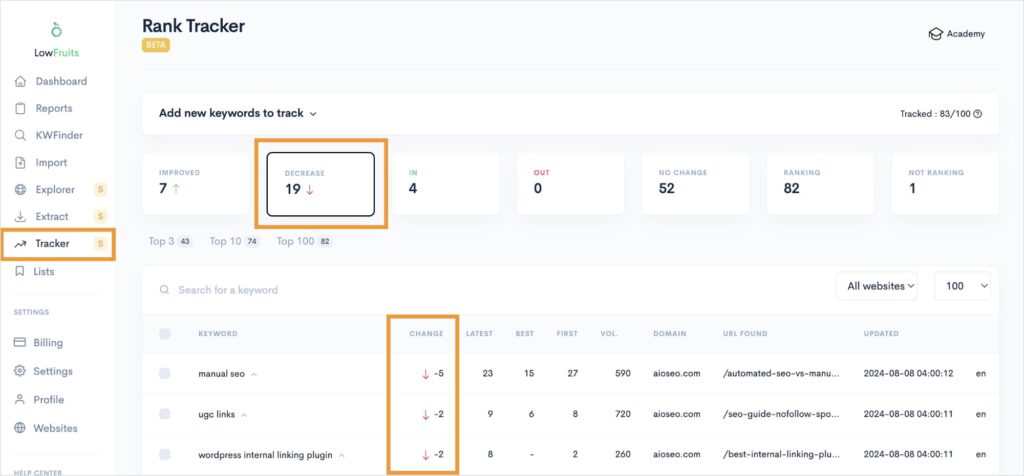
Note: The Rank Tracker requires a LowFruits subscription.
6. Optimize for SERP Features
SERP features are eye-catching elements that display more information on the SERP than standard listings. Optimizing for these features can significantly increase your website’s visibility and attract more clicks.
Some common SERP features include:
Featured snippets are one of the most coveted search results. These listings appear above all organic results in what SEO professionals call “position zero.”
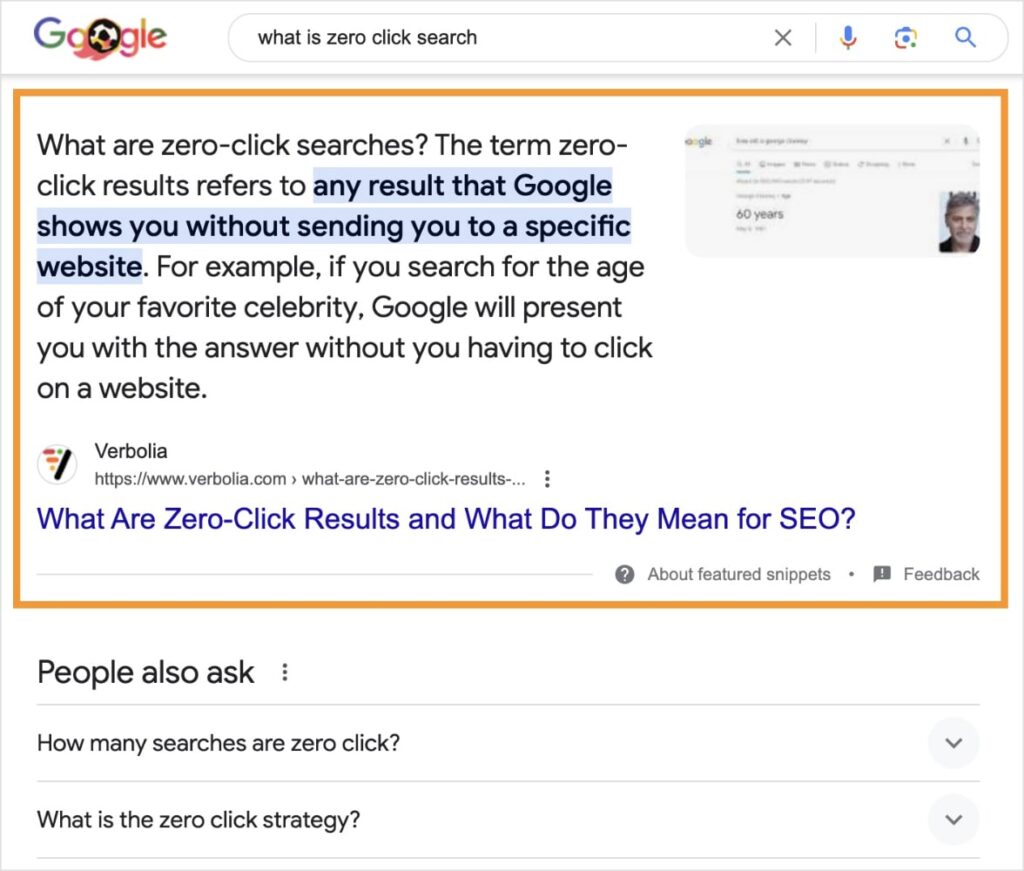
Rich snippets have additional features, like images, product details, customer ratings, etc.

The People Also Ask (PAA) section is another valuable SERP feature. This box presents users with related questions and answers to their original search query.
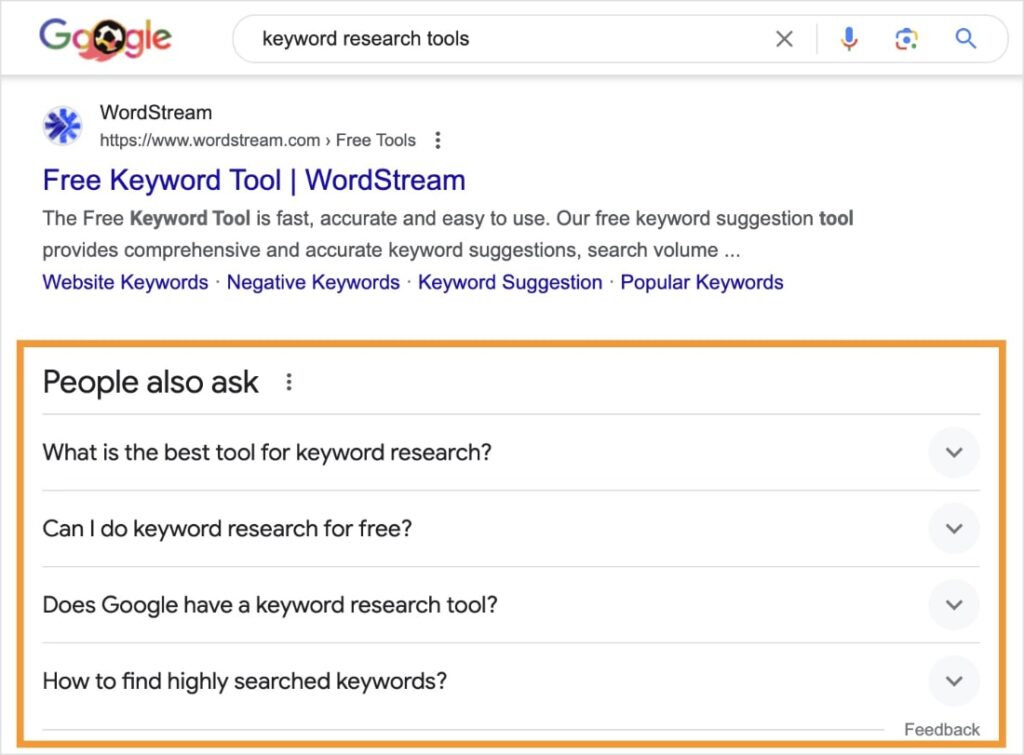
To increase your chances of appearing in SERP features, follow these tips:
- Create comprehensive and informative content. Answer user queries thoroughly and directly.
- Use clear and concise headings. Structure your content with clear headings and subheadings.
- Optimize for featured snippets and PAA rankings. Provide direct answers to questions in your content.
- Utilize schema markup. Help search engines understand your content better.
- Build authority. Establish your website as a trusted source in your industry.
By targeting SERP features, you can boost your website’s visibility and attract more organic traffic.
7. Implement Schema Markup
Schema markup is structured data that helps search engines understand your content better. It lives within the HTML code of your website.
Common schema types include:
- Article: For blog posts and news articles.
- Product: For e-commerce products.
- LocalBusiness: For local businesses.
- Organization: For businesses and organizations.
- Person: For individuals or authors.
To implement schema markup:
- Choose the appropriate schema type. Select the schema type that best represents your content.
- Use a schema markup tool. Tools like Google’s Structured Data Markup Helper can assist in creating schema markup code.
- Add the markup to your website. Insert the generated code into the header or body of your HTML.
- Test your markup. Use Google’s Rich Results Test to verify that your markup is implemented correctly.
Search engines can use schema markup to generate SERP features, so it’s critical to include it on your website.
If you’re a WordPress user, SEO plugins like All in One SEO (AIOSEO) simplify the process of adding schema to your site.
AIOSEO offers a Schema Generator that’s as quick as a click of a button. The plugin automatically formats the structured data for search engines, meaning you don’t have to touch code.
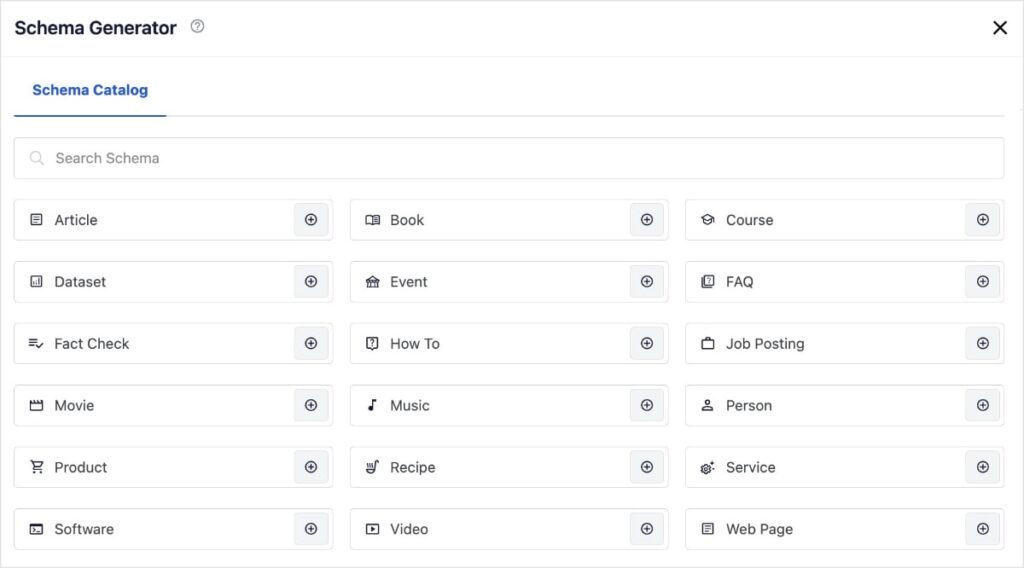
8. Promote Content on Social Media
Social media is a powerful tool for driving traffic to your website. By sharing your content on relevant platforms, you can reach a wider audience and increase brand awareness.
Here are some tips for effective social media promotion:
- Choose the right platforms. Identify the social media platforms where your target audience is most active.
- Create engaging content. Develop eye-catching visuals and compelling copy to accompany your posts.
- Use relevant hashtags. Increase your content’s visibility by using popular and relevant hashtags.
- Encourage sharing. Prompt your audience to share your content with their networks.
- Engage with your audience. Respond to comments and messages promptly.
Remember: Consistency is key.
Regular social media posting will help you build a loyal following and drive new visitors to your site.
9. Use Email Marketing
Email marketing is an effective method for nurturing leads and driving traffic to your website.
It’s also easily overlooked by small business owners who are short on time.
However, by building an engaged email list, you can connect with your existing audience with personalized content. This makes it highly effective for converting subscribers into loyal customers.
Here’s how to leverage email marketing for increased organic traffic:
- Build a high-quality email list. Offer valuable incentives to encourage sign-ups.
- Segment your email list. Tailor content to specific audience segments based on interests or behavior.
- Create compelling email content. Deliver valuable content that provides solutions to your audience’s problems.
- Optimize email subject line. Write attention-grabbing subject lines that encourage opens.
- Include strong calls to action. Guide subscribers to take desired actions, such as visiting your website.
These optimizations will help you connect with your audience ad drive targeted traffic to your site.
10. Run an SEO Audit
Regular SEO audits are essential for maintaining and improving your website’s performance. An SEO audit involves a comprehensive website analysis to identify areas for improvement.
Key areas to focus on during an SEO audit include:
- Technical SEO: Website speed, mobile-friendliness, indexing, and site structure.
- On-page SEO: Keyword optimization, title tags, meta descriptions, and header tags.
- Link building: Backlink analysis, link quality, and link acquisition strategies.
- Content analysis: Content relevance, quality, and consistency.
- User experience: Website navigation, usability, and mobile responsiveness.
By conducting regular SEO audits, you can identify and address issues that may be hindering your organic traffic growth.
Increase Organic Search Traffic With LowFruits
Increasing organic traffic is an ongoing process that requires a combination of SEO strategies and consistent effort. By implementing the ten methods outlined in this post, you can improve your website’s visibility, attract more qualified visitors, and achieve your online goals.
Remember: SEO is a long-term strategy. Stay patient, track your progress, and adapt your approach as needed.
LowFruits can help you streamline your SEO efforts and achieve faster results. Our tools were designed with small businesses in mind, empowering you to find low-competition keywords that get you to the top of the SERP.
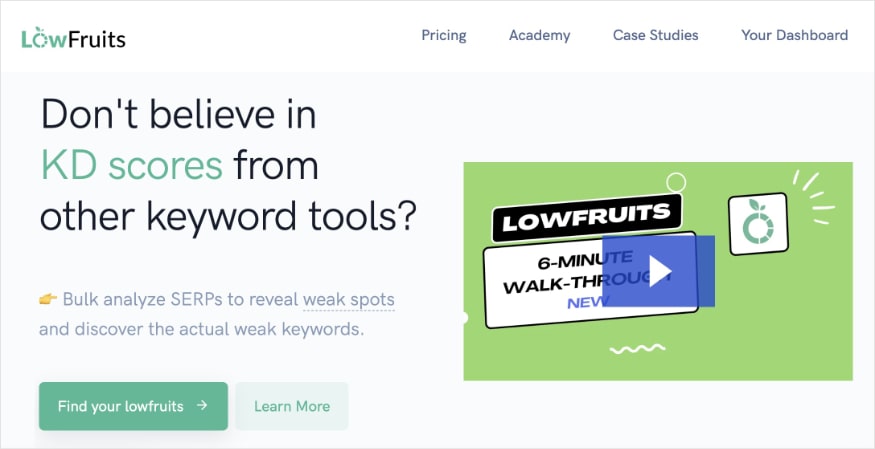
Whether it’s competitor keyword research, tracking SEO rankings, or performing SERP analyses, LowFruits has the tools you need to grow your online presence and achieve your business goals.
Sign up for a free trial today to see how LowFruits can help you increase your organic search traffic and rankings.